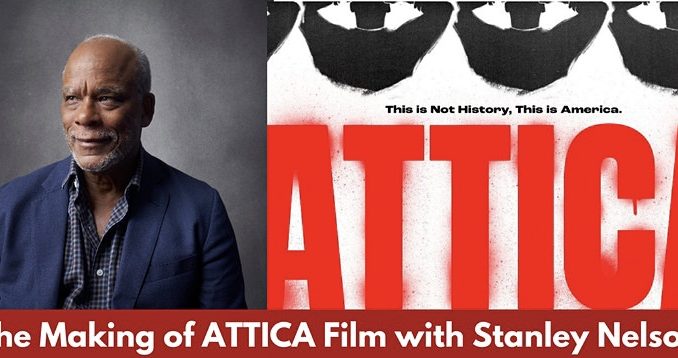
By ANNABELLE PAULINO
Documentarian Stanley Nelson discussed the footage, subject matter and memory of “Attica,” his film about one of the deadliest incidents in American prison history, at his alma mater, City College on Feb. 24.
Nelson is an Oscar-nominated and Emmy-winning director of numerous documentaries on the African American experience. “Attica,” his latest film, with Traci A. Curry, examines the infamous 1971 prison uprising in which 33 prisoners and 10 guards died. The film premiered at the opening night of the 2021 Toronto International Film Festival, on the exact date that the riot began, September 9th, 2021.
On September 9th, 1971, inmates rose up over cruel and inhumane treatment, overcrowding, censorship of letters and obscene living conditions that limited them to one shower per week and one roll of toilet paper each month. The prisoners seized control of the maximum-security correctional facility known as Attica, in upstate New York.
Eventually, state police retook most of the prison, but 1,281 prisoners occupied an exercise field called D yard, where they held 39 prison guards and employees hostage for four days, while they negotiated their demands.
Many Attica prisoners began to perceive themselves as political prisoners rather than convicted criminals.
When negotiations stalled, New York State Governor Nelson Rockefeller and the police made the decision to launch a disastrous raid on September 13th. On that day, a helicopter dropped tear gas from the sky — as state police rushed the yard and fired 3,000 rounds — killing 10 hostages and 29 inmates. By the time the uprising was over, 43 people were dead.
Felicia Harden, filmmaker and Professor at City College interviewed Nelson about the editing process of “Attica,” and asked him about the use of profanity, and vivid imagery with the footage he used.
“They [inmates] experienced this uprising at Attica in 1971, and I wanted them to just tell the experience however they felt comfortable telling it. It’s a hard story to relive and when you have to go back in time to tell it, it’s hard to control the rawness of someone’s experience. The subjects in the film are what made this film come together,” said Nelson
“Attica” is a film that Nelson was intending to make for thirty years. Due to Covid, the film was stalled, which made it a challenge for the film to be completed. The process of making “Attica” started with a trailer as a trial, which later on was picked up by television network Showtime. “When I finally decided that I was going to go for it, I knew it was the right thing to do,” said Nelson.
“Attica” cost 1.5 million dollars to make, and where most of the funds went was for the footage that was used to tell the story. That footage included archives from Attica prison, tape from ABC’s journalist John Johnson who was one of the correspondents that covered the riot, and CBS archives to name a few.
The editing behind “Attica” included what types of footage Nelson needed to tell the story from both sides of the prison walls. Nelson and his archive director delved into perspectives from news footage, prisoners, lawyers, and notably footage from Attica.
“Surprisingly, it wasn’t a challenge to get the footage from Attica. Since the film follows the story from different angles, the prisoners, the guards, news stations and it was a heavily filmed incident in 1971, it was a matter of finding the exact footage we needed that went along with how the story was being told,” said Nelson.
In the documentary, Nelson didn’t address modern-day issues with prison reform and the status of the correctional system. His directorial intent was to keep the story of the 1971 riot in Attica prison as a reflection, a memory, or a moment in history just as is.
“It’s not one of those films where you clap at the end. It’s supposed to inform about the injustices, repression, abuse, and inhumane conditions of the 1971 inmates who experienced the uprising in Attica. What went down in those days and what was done before, during, and the aftermath of the riot,” said Nelson.
The year 2021 was the 50th anniversary of this deadly repression, and its legacy remains in the work of activists working for change to the incarceration system and prison reform. Nelson includes rare interviews with survivors from both sides of the prison walls. The film lets one really see what happened at Attica like nothing before. “Attica” resonates with, “It definitely didn’t have to end that way,” said Nelson.
The film’s definitive, stirring, and devastating conclusion marks the 1971 prison uprising as the most disturbing the country has ever witnessed. Showtime has made Stanley Nelson’s emotionally remembered documentary available for free on its website and on Youtube until April.
